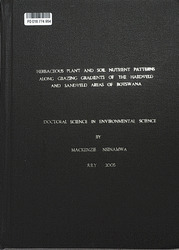| dc.description.abstract | Vegetation changes associated with grazing by domestic livestock have been studied throughout the major grazing savannas of the world. Changes have been documented to differ from area to area depending on stock composition, management strategies, rainfall patterns and vegetation and soil types among others. In extensive and open grazing systems, vegetation changes are complex to understand, the major challenge confronting managers being the uneven use of herbaceous forage plants by livestock. Grazing is limited or found concentrated in preferred areas or around foci (e.g. water points), eventually and gradually exerting changes on vegetation structure, production, composition, seed-bank stock, and soil and plant nutrient status. In Botswana’s communal grazing systems, however, the severity or magnitude of this foregoing problem is little understood. This study therefore investigated herbaceous plant species patterns, soil and grass plants nutrients status and seed-bank stock analysis along grazing gradients in the sandveld and hardveld communal grazing areas of Botswana. Six boreholes (3 in each zone), with sampling points at distances 50,100,200,400,800, 1500 and 3000 m formed part of the investigation. At each sampling distance, 2 plots measuring 10m x 15m (fenced and unfenced) were designated, where soil and herbaceous plant samples were collected for further chemical analysis, over a period of two years. Significant biomass production variation (p =0.0001) was noted between the two land zones. In general, biomass production was higher in the sandveld compared to the hardveld. In addition, biomass tended to increase with distance with higher production in fenced than unfenced plots as evidenced in both study sites. Marked differences in soil nutrients, herbaceous plant nutrients, species composition and diversity were prominent between the two land zones. Soils from the hardveld boreholes recorded significantly higher concentration levels of macro and microelements relative to the sandveld. Apparently negative correlations between soil and plant elements were established for the two land zones, with grasses of the hardveld showing higher concentration levels. Herbaceous plant species from the hardveld boreholes contained adequate macro and microelements to meet dietary livestock requirements compared to the sandveld. An analysis of the management implications of these results is discussed in this thesis, specifically addressing issues related to distance intervals between permanent versus multiple water sources, as means of restricting proliferation of invader forbs species. | en_US |

